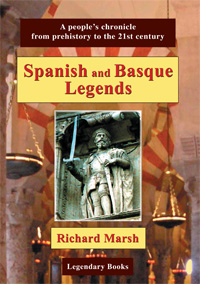Visitors to Buber’s Basque Page likely already know Andy Franco. Since discovering his Basque roots, he has been very involved in the Boise Basque community. Owner of Calico Forge and Knife Company, Andy has weaved his Basque heritage into his work. He made the replica harpoons that were featured in the Boise Basque Museum’s exhibit on Basque whaling and he also created the amazing lauburu that he donated for the 2008 dinner/fundraiser for the Boise Basque Museum and Cultural Center.
His focus more recently has been knives, as evident by his company website. New Mexico Euskal Etxea asked Andy if he would be interested and able to donate something for our own fundraiser, a Tapas and Wine event to be held on June 19. Andy seized the opportunity to take his knife-making in a direction he’d been thinking about for some time: kitchen knives. He made two beautiful knives, pictured below, that he generously donated to NMEE. He also made an iron stone hunter knife, also pictured (with the rougher-decorated blade). All three pieces are wonderful. We thank Andy for his generosity in sharing his amazing skills with us.




 Holly Emblem is the editor of CasinoOnline.co.uk. They recently published an
Holly Emblem is the editor of CasinoOnline.co.uk. They recently published an 







